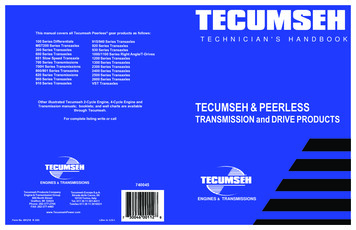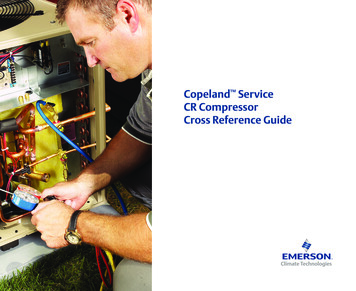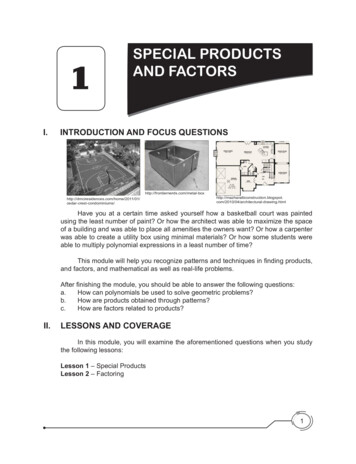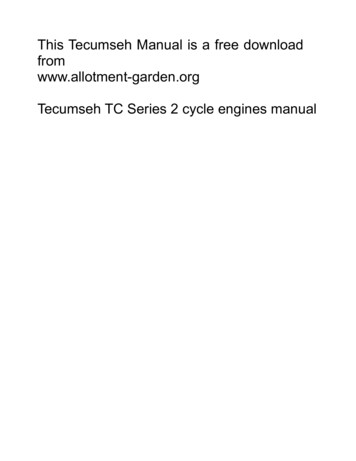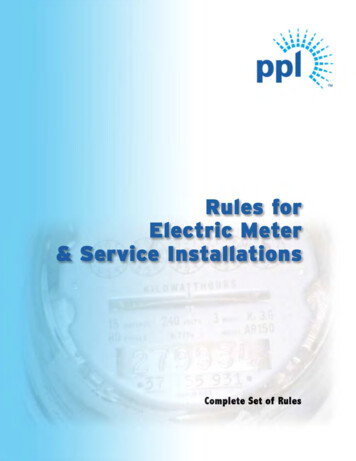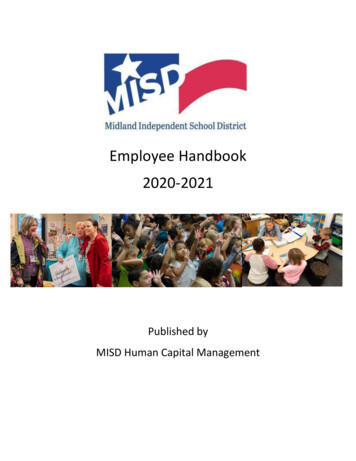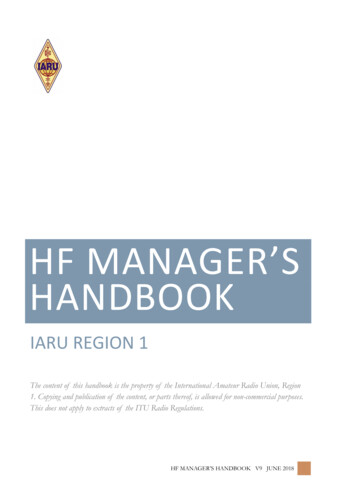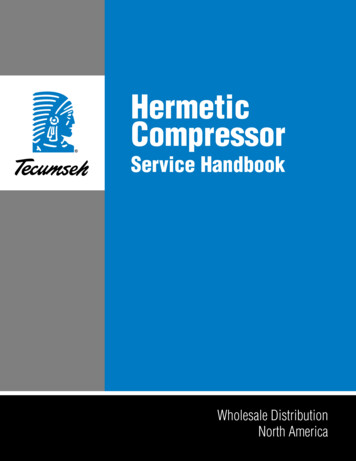
Transcription
HermeticCompressorService HandbookWholesale DistributionNorth America
Hermetic CompressorService HandbookAnn Arbor, MI 48108REV 3/11
Handbook Purpose and DescriptionTecumseh Products Company has prepared this Service Handbook to assist service personnel insafely installing and servicing refrigeration and air conditioning equipment. The information in thisService Handbook is generally limited to the compressor and to items and conditions affecting theinstallation, operation, and servicing of the compressor. It is not designed to be a textbook or toreplace the training required for professional service technicians. Also, it is not intended to replaceother information available from the refrigeration and air conditioning system manufacturers.
General Service Safety Precautions1Introduction 2Trained Personnel Only 2Terminal Venting and Electrocution 2Refrigerants and Other Chemicals 4Compressor Removal 4System Flushing, Purging, and Pressure Testing for Leaks 4System Charging 5Prevention of Water-Utilizing System Explosions 6Start Capacitor Overheating 7System Evacuation 7Follow the Labels 8Model and Application9Compressor Model Number Codes 10Condensing Unit Model Number Codes 11Serial Label Information 12Basic Application Information for Hermetic Compressors 13Compressor Motor and Component15Single-phase Compressor Motor Types 16PSC Motor Starting 17Hermetic Compressor Thermal Protectors 19Compressor Motor Starting Relays 21Selecting Capacitors 24Identification of Terminal Pins 26Fuse and Circuit Breaker Sizing 26
Table of ContentsServicing29Introduction to Servicing 31Think Safety. 31Before Servicing 31Servicing or Troubleshooting Water-utilizing Systems: Preventing Explosions 32Troubleshooting Chart 34Installation and Replacement73Compressor Tube Connections 74Refrigerant Line Sizes 76Service Valves 82Processing the System 82System Cleanup and Compressor Replacement After Compressor Failure 83Replacing Compressors in Water-Utilizing Systems: Preventing Explosions 87Operation89Control of Liquid Migration to the Compressor During Shutdown 90Crankcase Heaters 93Starting a System with Liquid Refrigerant in the Compressor 94Control of Liquid Refrigerant Floodback to the Compressor During Operation 95Accumulator Selection 98Internal Pressure Relief Valves 99Appendix101The Basic Refrigeration Cycle 102Example of a Tecumseh Hermetic Compressor 104Reciprocating Compressor 105Capillary Tube Sizing 106Approved Hermetic Compressor Oils 108Notes 110
General ServiceSafety PrecautionsChapter 1
2SERVICE HANDBOOKIntroductionTecumseh Products Company has prepared this handbook to assist service personnel in safelyworking with refrigeration and air conditioning equipment that uses Tecumseh Products Companyhermetic compressors. It is not designed to replace the training required for professional servicepersonnel. It is also not intended to replace other information available from refrigeration and airconditioning equipment manufacturers.Trained Personnel OnlyServicing, repairing, and troubleshooting refrigeration and air conditioning systems should be doneonly by those with the necessary knowledge, training, and equipment.Terminal Venting and ElectrocutionImproperly servicing, repairing, or troubleshooting a compressor can lead to electrocution or fire dueto terminal venting with ignition. Follow the precautions below to avoid serious injury or death fromelectrocution or terminal venting with ignition.Fire Hazard from Terminal Venting with IgnitionOil and refrigerant can spray out of the compressor if one ofthe terminal pins is ejected from the hermetic terminal. This“terminal venting” can occur as a result of a ground fault(also known as a short circuit to ground) in the compressor.The oil and refrigerant spray from terminal venting can beignited by electricity and produce flames that can leadto serious burns or death. See figures 1-1 through 1-3 fordetails.!WARNINGNever service, repair, or troubleshoot unlessyou are qualified to perform these functions.Improper servicing can lead to seriousinjury or death from fire, electrical shock, orexplosion.Terminal Venting and Electrocution PrecautionsTo reduce the risk of electrocution or serious burns or death from terminal venting withignition: Be alert for sounds of arcing (sizzling, sputtering or popping) inside the compressor.IMMEDIATELY GET AWAY if you hear these sounds. Disconnect ALL electrical power before removing the protective terminal cover. Makesure that all power legs are open. (NOTE: The system may have morethan one power supply.) Never energize the system unless: 1) the protective terminal cover issecurely fastened, and 2) the compressor is properly connected to ground.Figures 1-4 through 1-6 illustrate the different means of fastening protectiveterminal covers. Never reset a breaker or replace a fuse without first checking for a ground fault(a short circuit to ground).An open fuse or tripped circuit breaker is a strong indication of a ground fault (also knowas a short circuit to ground). Use only a megohmmeter (“megger”) or a Hi-Potential Groundtester (Hi-Pot) to check for a ground fault. A conventional ohmmeter will not reliably detecta ground fault under certain circumstances. See the Service Handbook for more information on checking for a ground fault. Also, always follow the megger or Hi-Pot manufacturer’sprocedures and safety rules.If a ground fault does exist, keep the power off. WARNING! To avoid electric shock, electrocution, and terminal venting with ignition, do not energize a compressor that has a ground
3fault. Mark and red tag the compressor to indicate that there is a ground fault. Do not reconnect the power leads. Tape and insulate each power lead separately. Disconnect power before servicing. Always disconnect power before servicing unlessit is required for a specific troubleshooting technique. In these situations, use extremecaution to avoid electric shock.FIGURE 1-1: Compressorwith (1) protective cover and(2) bale strap removed toshow (3) hermetic terminal.FIGURE 1-2: Close up viewof hermetic terminal showing individual terminal pinswith power leads removed.FIGURE 1-3: Close up viewof hermetic teminal after ithas vented.FIGURE 1-4: Compressorwith (1) protective coverheld in place by (2) metalbale strap.FIGURE 1-5: Compressorwith (1) protective coverheld in place by (2) nut.FIGURE 1-6: Compressorwith (1) snap in protectivecover.
4SERVICE HANDBOOKRefrigerants and Other ChemicalsContact with refrigerant, mixtures of refrigerant and oil, or other chemicals can cause a varietyof injuries including burns and frostbite. For example, if refrigerant contacts skin or eyes, it cancause severe frostbite. Also, in the event of a compressor motor failure, some refrigerant and oilmixtures can be acidic and can cause chemical burns.To avoid injury, wear appropriate protective eye wear, gloves, and clothing when servicing an airconditioning or refrigeration system. Refer to your refrigerant supplier for more information.If refrigerant or mixtures of refrigerant and oil come in contact with skin or eyes, flush the exposedarea with water and get medical attention immediately.Compressor RemovalFailure to properly remove the compressor can result in serious injury or death from electrocution,fire, or sudden release of refrigerant and oil.Follow these precautions when removing a compressor from a system: Disconnect ALL electrical power. Disconnect all electrical power supplies to the systemmaking sure that all power legs are open. (NOTE: the system may have more thanone power supply.) Be sure refrigerant is recovered before removing compressor. Attempting to removethe compressor before removing all refrigerant from the system can cause a suddenrelease of refrigerant and oil. Among other things, this can:»cause»a variety of injuries including burns and frostbite.»cause»a fire if a torch is used to disconnect tubing.»expose»the service person to toxic gas. To avoid serious injury or death, be sure to remove and recover allrefrigerant before removing the compressor. Use a tubing cutter, not a torch. Use a tubing cutter to remove the compressor. A torchcan cause even trace amounts of refrigerant to decompose and release toxic fumes.In addition, using a torch to remove the compressor can cause a fire. If you ignore thisrecommendation and use a torch, be prepared to extinguish a fire.System Flushing, Purging, and Pressure Testing for LeaksFailure to properly purge or pressure test a system for leaks can result in serious injury or deathfrom explosion, fire, or contact with acid-saturated refrigerant or oil mists.Follow these precautions when purging or pressure testing a system for leaks: Tecumseh discourages the use of flushing products and recommends the use ofsuction line filter-drier and proper oil changes. If the use of a flushing agent is absolutelynecessary, follow the flushing agent manufacturer's instructions. To purge a system, use only dry nitrogen. When pressure testing for leaks, use only regulated dry nitrogen or dry nitrogen plustrace amounts of the serial label refrigerant. When purging or pressure testing any refrigeration or air conditioning system for leaks,never use air, oxygen or acetylene.»Oxygen»can explode on contact with oil.»Acetylene»can decompose and explode when exposed to pressure greater thanapproximately 15 psig.»Combining»an oxidizing gas such as oxygen or air, with an HCFC or HFC refrigerantunder pressure can result in a fire or explosion.
5 Use a pressure regulating valve and pressure gauges.Commercial cylinders of nitrogen contain pressures in excess of 2000 psig at 70 F. Atpressures much lower than 2000 psig, compressors can explode and cause seriousinjury or death. To avoid over pressurizing the system, always use a pressure-regulatingvalve on the nitrogen cylinder discharge (see Figure 1-7). The pressure regulator mustbe able to reduce the pressure down to 1 or 2 psig and maintain this pressure.The regulating valve must be equipped with two pressure gauges:»one»gauge to measure cylinder pressure, and»one»gauge to measure discharge or downstream pressure. Use a pressure relief valve.In addition to a pressure regulating valve and gauges, always install a pressure reliefvalve. This can also be a frangible disc type pressure relief device. This device shouldhave a discharge port of at least ½” MPT size. The valve or frangible disc device mustbe set to release at 175 psig (see Figure 1-7). Do not pressurize the system beyond 150 psig field leak test pressure.When field testing a system for leaks, 150 psig is adequate test pressure. Disconnect nitrogen cylinder and evacuate the system before connecting the refrigerantcontainer.Disconnect the nitrogen cylinder and evacuate the system according to the equipmentmanufacturer's recommendations prior to charging the system.System ChargingFailure to properly charge the system can result in serious injury or death from explosion or fire.Follow these precautions when charging a system: Do not operate the compressor without charge in thesystem.Operating the compressor without a charge in thesystem can damage the hermetic terminal. As always,to avoid serious injury or death from terminal ventingwith ignition, never energize the compressor unless theprotective terminal cover is securely fastened. GaugesRegulatingValveUse proper refrigerant.To SystemRelief ValveUse only the serial label refrigerant when chargingthe system. Using a different refrigerant can lead toexcess system pressure and an explosion. Use of arefrigerant other than the serial label refrigerant will void the compressor warranty. FIGURE 1-7Dry nitrogen cylinder withattached pressure gaugesneeded for pressure testingfor leaks and purging.Do not overcharge a refrigeration or air conditioning system.Overcharging a refrigeration or air conditioning system can result in explosion. To avoidserious injury or death, never overcharge the system. Always use proper chargingtechniques. Limit charge amounts to those specified on the system equipment seriallabel or in the original equipment manufacturer’s service information.Overcharging the system immerses the compressor motor, piston, connecting rods,and cylinders in liquid refrigerant. This creates a hydraulic block preventing thecompressor from starting. The hydraulic block is also known as locked rotor.Continued supply of electricity to the system causes heat to build in the compressor.This heat will eventually vaporize the refrigerant and rapidly increase system pressure.If, for any reason, the thermal protector fails to open the electrical circuit, systempressure can rise to high enough levels to cause a compressor housing explosion.
6SERVICE HANDBOOKPrevention of Water-Utilizing System ExplosionsIn certain water-utilizing refrigeration systems, water can leak into the refrigerant side of the system. This can lead to an explosion of system components including, but not limited to, the compressor. If such an explosion occurs, the resulting blast can kill or seriously injure anyone in thevicinity.Systems at Risk of ExplosionWater-utilizing systems that have single-wall heat exchangers may present a risk of explosion. Such systems may include: water source heat pump/air conditioning systems, and water cooling systems, such as icemakers, water coolers, and juice dispensers.Water-utilizing systems that have single-wall heat exchangers present a risk of explosionunless they have either: a high pressure cut-out which interrupts power to ALL leads to the compressor, or an external pressure relief valve.How an Explosion OccursIf the refrigerant tubing in the heat exchanger develops a leak, water can enter the refrigerant side of the system. Water entering the refrigerant side can come in contact with liveelectrical connections in the compressor causing a short circuit or a path to ground. Whenthis occurs, extremely high temperatures can result. The heat build-up creates steamvapor that can cause excessive pressure throughout the entire system. This system pressure can lead to an explosion of the compressor or other system components.Service ProceduresIn light of the risk of explosion, be especially alert for signs of water leaking into the refrigerant side of the system. Whenever servicing or troubleshooting a water-utilizing system,always check to see if it has either a pressure relief valve or a high-pressure cutout as previously described. If the system does not have at least one of these, DISCONNECT ALLELECTRICAL POWER and look for indications that water has leaked into the refrigerantside of the system. These indications may include: Observation or a report of a blown fuse or tripped circuit breaker. Signs that water has leaked to the outside of the system. Reports that the system has made gurgling or percolating noises. A history of loss of refrigerant charge without a leak being found in the system.NOTE: Common leak detection methods will not detect a water-to-refrigerantleak in the system’s heat exchanger(s). Observation of or a report of the compressor giving off an unusual amount of heat.If ANY of these indications are present, do the following checks to determine if water hasleaked into the refrigerant side:Step 1: Check for a Ground Fault (a Short to Ground)Use only a megohmmeter (“megger”) or a Hi-Potential Ground tester (“Hi-Pot”) to check for aground fault. A conventional ohmmeter will not reliably detect a ground fault under certain circumstances. To check for a ground fault, use the procedure outlined on pages 40-41. If a ground fault does not exist, go to Step 2. If a ground fault does exist, keep the power off.
7WARNING! To avoid electric shock, electrocution and terminal venting with ignition, do not energize a compressor that has a ground fault. Mark and red tag thecompressor to indicate that there is a ground fault. Do not reconnect the powerleads. Tape and insulate each power lead separately. Proceed to Step 2. Do notreplace the compressor or energize the system before performing Step 2.Step 2: Check for Water in the SystemOnce the compressor is cool to the touch, open the system process valve slightly to see ifany water comes out of the system. WARNING! Opening the system process valve whilethe compressor is hot can cause severe burns from steam coming out of the valve.If ANY water comes out of the process valve, the entire system must be replaced. See"replacing a Single-wall Water-utilizing System” below.If water does not come out of the process valve, there is still a possibility that some waterhas leaked into the refrigerant side of the system. To address this possibility, determine ifthe system has a history of losing refrigerant charge without a leak being found or repaired.If you find ANY indication of a history of losing refrigerant charge without detection of aleak, this is a sign that refrigerant has leaked in the water inside the heat exchanger. Theentire system must be replaced. See “Replacing a Single-wall Water-utilizing System” onpage 33.If you do not find any indication of a history of loss of charge without detection of a leak,you still need to install:»a» high-pressure cut-out which interrupts power to ALL leads to the compressor, or»an» external pressure relief valve.Also, if you found a ground fault in the compressor in Step 1, replace the compressor before applying power to the system.Start Capacitor OverheatingAn overheated start capacitor can burst and spray or splatter hot material that can cause burns.Applying voltage to a start capacitor for more than a few seconds can cause the capacitor tooverheat.Check capacitors with a capacitance meter, and never check a capacitor with the power on.System EvacuationNever use a compressor to evacuate a system. Instead, use a high-vacuum pump specificallydesigned for that purpose.Never start the compressor while it is under deep vacuum. Always break a vacuum with a minimum 2 psig refrigerant charge before energizing the compressor.The compressor is cooled primarily by the flow of refrigerant. Running a system that is low oncharge will reduce the life of the comperssor.Failure to follow these instructions can damage the hermetic terminal. As always, to avoid serious injury or death from terminal venting with ignition, never energize the compressor unless theprotective terminal cover is securely fastened.
Model and ApplicationChapter 2
10SERVICE HANDBOOKTecumseh Compressor Model Number licationNumber ofDigits inRated BTUCapacityFirst TwoDigits ofRated BTUCapacityRefrigerantVoltageCondensingUnitsA 1stB 2ndC 3rdetc.In this example (4) totaldigits, with the first two (40),or 4,000 BTU capacityPrimary Application ParametersEvapRating Motor StartingTemperaturePointTorque1. Low-10 FNormal2. Low-10 FHigh3. High 45 FNormal4. High 45 FHigh5. Air Cond 45 FNormal6. Medium 20 FNormal7. Medium 20 FHigh8. Air Cond 49 FNormal9. Commercial 20 FHigh0. Commercial 20 FNormalF. Low – Vapor Inj-10 FHighG. Low – Vapor Inj-10 FHighPrimaryRefrigerantsA R12B R410AC R407CE R22J R502U R290M R600aY R134aZ R404A/R507See unit informationin Condensing UnitsFast ReferenceVoltage CodesXA 115-60-1; 100-50-1XB 230-60-1; 200-50-1XC 220-240-50-1XD 208-230-60-1; 200-50-1XF 208-230-60-3;200-240-50-3XG 460-60-3; 380-420-50-3XH 575-60-3; 480-520-50-3XN 208-230-60-1; 200-220-50-1XP 220-60-1; 200-50-1XT 200-230-60-3; 200-220-50-3XU 100-60-1; 100-50-1XV 265-60-1AB 115-60-1; 90-50-1VA 265-60-1; 220-240-50-1NA 208-230-60-1NOTE: For explanation of compressor families and codes,contact Tecumseh Products Company.FIGURE 2-1: Compressor model number codesAA 115-60-1
11AStandard UnitBStd. Unit W/Receiver TankCStd. Unit W/Receiver Tank & BX CableDStd. Unit W/BX CableE,F,KPhysical Design Variant (Conduit)G,H,J,L,P Physical Design Variant (Standard)MAdvanced Commercial DesignNAdvanced Commercial DesignSCustomer SpecialTInterconnect CompressorUWater Cooled - Adv. Commercial DesignVElectrical Special (Conduit Design)WWater Cooled UnitXInterconnect UnitYAir Water Cooled UnitZElectrical Special (Standard Unit)Evaporative Condensate Units Plastic BaseECLarge Evaporative Condensate Units Black Plastic BaseEDLarge Evaporative Condensate Units Black Plastic BaseEELarge Evaporative Condensate Units Black Plastic BaseGCSmall - Fan Guard, Power Cord, Receiver Tank, Service ValvesGBSmall - Fan Guard, Power Cord, Receiver TankGKSmall - Fan Guard, Power CordGLSmall - Fan GuardOutdoor Condensing UnitsHLOutdoor Condensing Unit with Options Celseon Air Cooled UnitsStd. Unit W/EC Fan Motor, Sweat Conns, Power Cord &CBReceiver TankStd. Unit W/EC Fan Motor, Sweat Conns, Power Cord,CCReceiver Tank & Service ValvesCKStd. Unit W/EC Fan Motor, Sweat Conns, Power CordStd. Unit W/EC Fan Motor, Sweat Conns, Power Cord &CSService ValvesStd. Unit W/SP Fan Motor, Sweat Conns, Power Cord &SBReceiver TankStd. Unit W/SP Fan Motor, Sweat Conns, Power Cord,SCReceiver Tank & Service ValvesSKStd. Unit W/SP Fan Motor, Sweat Conns, Power CordStd. Unit W/SP Fan Motor, Sweat Conns, Power Cord &SSService Valves AccumulatorSee B/MInterconnectCompressorBX CableReceiverTankThe letters I, O, and Q are eliminatedAir WaterCooledCondensing Unit Features, see chart belowWaterCooledCondensing UnitModel Number CodesE and G Evaporative Condensate UnitsS Shaded Pole Fan Motor (Celseon)C Electrically Commutated Fan Motor (Celseon)X A holding character, reserved for future useH Housed UnitFanCooledAEA4440YXA XC FIGURE 2-2: Condensing Unit model number codes
12SERVICE HANDBOOKFollow the LabelsTecumseh Products Company compressors have labels and markings with important information. For your safety and the safety of others, read the labels and markings on the product.Serial Label InformationThe only source for complete compressor information is on the compressor serial label. On earliercompressors, the serial plate is usually spot-welded on the upper housing of the compressor. Forcurrent compressors, the serial label is affixed in the same location. Both describe the characteristics of the compressor.The months are identified in Table 2-1.SERIAL NUMBERBILL OF MATERIAL NUMBERSECOND LETTER INDICATES MONTH(SEE TABLE 2-1), NEXT TWO DIGITSINDICATE DAY OF MONTH, THEFOLLOWING 2 DIGITS INDICATE YEARELECTRICAL RATINGVOLTS - HERTZAH301FT - 077SE1490C281254AH5540EV230/208HZ60V200 HZ50 PHILRA103.0USAPPHASEFIGURE 2-3:BILL OF MATERIAL NUMBERCOMPRESSORMODEL NUMGERExample of compressor serial plateELECTRICAL RATINGVOLTS - HERTZ - LRA - PHASECOMPRESSORMODEL NUMBERLETTER INDICATES MONTH (SEE TABLE 2-1), NEXT 2 DIGITS INDICATE DAYOF THE MONTH, FOLLOWING 2 DIGITS INDICATE YEARFIGURE 2-4:Example of compressor serial labelMANUFACTURING CODE DATEMONTH SEPTEMBERJ2400YEAR 2000DAY 24THE LETTER REPRESENTS THE MONTH(SEE TABLE 2-1).THE NUMBERS REPRESENT THE YEAR.FIGURE 2-5:Example of condensing unit serial label
13Table 2-1: Serial Label Month IdentifiersA – JanuaryB – FebruaryC – MarchD – AprilE – MayF – JuneG – JulyH – AugustJ – SeptemberK – OctoberL – NovemberM – DecemberBasic Application Information for Hermetic CompressorsTecumseh hermetic compressors are engineered to do specific air conditioning and refrigerationtasks. Hermetic compressors are designed for a particular evaporator temperature range and aspecific refrigerant.Evaporator TemperaturesThe key specification is the evaporator temperature of the system. Compressors that areoperating outside their design evaporator temperature range can be expected to havepoor pumping efficiency and experience motor problems.Tecumseh hermetic compressors are designed for one of the following evaporatortemperature ranges shown in Table 2-2.RefrigerantUse only the serial label refrigerant when charging the system. Using a different refrigerantcan lead to excess system pressure, damage to the compressor and an explosion. Forexample, using R-404A in a compressor designed for R-134a can lead to higher operatingpressures that can overload the bearings and overwork the motor. Use of a refrigerantother than the serial label refrigerant will void the compressor warranty.Table 2-2: Evaporator Temperature RangesApplicationApproved Evaporator TemperaturesAir conditioning 32 F to 55 FImproved performance air conditioning 32 F to 57 FHeat pump (approved models)-15 F to 55 FHigh evaporator temperature 20 F to 55 FMedium evaporator temperature-10 F to 30 FLow evaporator temperature(normal torque motor)-10 F to 30 FLow evaporator temperature(high torque motor)-40 F to 10 FCommercial0 F to 50 F*Low Evaporator Temperature - Vapor Injection(high torgue motor)-40 F to 10 FLow Evaporator Temperature - Liquid Injection(high torque motor)-40 F to 10 F*Some exceptions exist, contact Tecumseh Products Company
CompressorMotor and ComponentChapter 3
Line 2(115 Volt Only - Neutral)SSingle-phase Compressor MotorTypesGroundMain WindingCCompressorfor- UnitTecumseh hermetic compressors contain motors designedspecific requirements of startingGroundRtorque and running efficiency. There are four general types of single-phase motors,each disRelaytinctly different from the others. Each type of motor may have two to four differentPTCconfigurationsdepending on the compressor components.Resistance Start — Induction Run (RSIR)The CSIR motor is similar to RSIR except a start capacitor is included inseries with start winding to producea higher starting torque (see Figure3-3). This is commonly used on commercial refrigeration systems through¾ HP. Two types of relays are usedwith this motor: a current relay, or a potential relay.Capacitor Start and Run (CSR)This motor arrangement uses a startcapacitor and a run capacitor in parallel with each other and in series withthe motor start winding (see Figure3-4). This motor has high startingtorque, runs efficiently, and is usedon many refrigeration and air conditioning applications through 5 HP. ARPTC RelayCompressor - UnitGroundRSIR motor diagram with currentrelayExternal ThermalProtectorAlt. 3/4" ThermalControl Protector External ThermalProtector CControlCLine 14 T M Thermal ProtectorLine 11 ControlLineRelay - Current CRelay - Current SLine 2(115Only - Neutral)StartVoltCapacitorSLine 2SGroundLine 2- Unit(115Compressor)Volt Only - NeutralGroundGround GroundCompressor - UnitGround - UnitCompressorGroundFIGURE 3-2:Line 1Main WindingMain WindingRCompressor - UnitGround GroundFIGURE 3-1:Start WindingStar t WindingSSRRMain WindingMainWindingMainWindingCapacitor Start — InductionRun (CSIR)CRelay - CurrentRPTC RelayRSIR motor diagram with wired-inPTC relayControlControlLine1 Thermal ProtectorAlt. 3/4"4 T M Thermal ProtectorStart CapacitorLine 1 ControlExternal ThermalExternalThermalProtectorProtector CCRelay - CurrentRelay - CurrentSSLine 2CGroundGroundGroundCompressor - UnitCompressor- UnitGroundCompressor- UnitGroundGroundS(115 2Volt Only - Neutral)LineLine2 ConductorIdentified(115 Volt Only - Neutral)RRRPTC RelayFIGURE 3-3: CSIR motor diagramExternal ing a module Positive TemperatureCoefficient (PTC) relay.CStartWindingStart WindingStart Winding a wired-in Positive TemperatureCoefficient (PTC) relay (see Figure3-2), or4 T M Thermal ProtectorLine 1 ControlLine 1Line 2Identified Conductor(115 Volt Only - Neutral)Line 2Ground(115 Volt Only - Neutral)External ThermalProtectorStartWindingStartWinding a current relay,Alt. 3/4" Thermal ProtectorControlStar t WindingThis motor, also known as a splitphase motor, is used on many smallhermetic compressors up through1/3 HP. The motor has low startingtorque and must be applied tocomplete self-equalizing capillarytube systems such as householdrefrigerators, freezers, small watercoolers, and dehumidifiers.Thismotor has a high resistance startwinding which is not designedto remain in the circuit after themotor has come up to speed (seeFigure 3-1). A relay is necessary toperform the function of disconnectingthe start winding as the motor comesup to design speed. Three types ofrelays are used with this motor:Main Winding16SERVICE HANDBOOKControlStart WindingLine 1
17 an internal thermal protector.Permanent Split Capacitor(PSC)Line 1ControlCRelay PotentialLine 2GroundCompressor Unit GroundSMain Winding an external thermal protector, orExternal or InternalThermal ProtectorStart Windingpotential relay removes the start capacitor from the circuit after the motor is up to speed. This motor mayuse either:RTo fully realize the capabilities of this simplifiedtype of compressor motor, it is necessaryto understand its starting and operatingcharacteristics and the field conditions thatcan affect it.The following conditions affect PSC motorstarting: Low voltage: Reduces motor starting and running torque. A 10%voltage drop reduces a motor’sstarting ability by 19%. Low voltage can cause no start, hard start,light flicker, and TV screen flip flop.C1Line 2Volt Only(115Line1 - Neutral)NCSPTCRelayThermal ProtectorRGroundPlug-InPTC Starting andRunCompressorCapacitor - Protector PackageUnit GroundC2PTCRelayC1Line 2(115 Volt Only - Neutral)Start WindingC2NCSRMain WindingMain WindingMain WindingTecumseh Products Company pioneered thedevelopment of Permanent Split Capacitorcompressor motors. This type of motor eliminates the need for potentially troublesomeand costly extra electrical components, e.g.,start capacitors and potential motor startingrelays (see Figure 3-5).Compressor RThermal ProtectorUnit GroundLine 1RunCapacitorCCPlug-InRun CapacitorStart WindingPSC Motor StartingSGroundMain WindingPSC motors are basically air conditioning compressor motors and arevery common up through 5 HP.Line 2PSC motor diagramFIGURE(115 Volt Only 3-5:- Neutral)GroundPTC Starting andCompressor - Protector PackageUnit GroundExt
Tecumseh Products Company has prepared this handbook to assist service personnel in safely . Use a pressure regulating valve and pressure gauges. Commercial cylinders of nitrogen contain pressures in excess of 2000 psig at 70 F. At pressures much lower than
